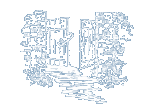



 | 


|
|
The ChipmunkTeacher's Story
Chipmunks are more easily tamed than red squirrels and soon learn that pockets may contain nuts and other things good to eat. The first tame chipmunk of my acquaintance belonged to a species found in the California mountains. He was a beautiful little creature and loved to play about his mistress' room; she, being a naturalist as well as a poet, was able to understand her little companion, and the relations between them were full of mutual confidence. He was fond of English walnuts and would always hide away all that were placed in a dish on the table. One day his mistress, when taking off her bonnet after returning from church, discovered several of these nuts tucked safely in the velvet bows; they were invisible from the front but perfectly visible from the side. Even yet, she wonders what the people at church that day thought of her original ideas in millinery; and she wonders still more how "Chipsie" managed to get into the bonnet-box, the cover of which was always carefully closed.
The chipmunk is a good home builder and carries off, presumably in its cheek pouches, all of the soil which it removes in making its burrow. The burrow is made usually in a dry hillside, the passageway just large enough for its own body, widening to a nest which is well bedded down. There is usually a back door also, so that in case of necessity, the inmate can escape. It retires to this nest in late November and does not appear again until March. In the nest, it stores nuts and other grains so that when it wakens, at long intervals, it can take refreshment. If you really wish to know whether you see what you look at or not, test yourself by trying to describe the length, position and number of the chipmunk's stripes. These stripes, like those of the tiger in the jungle, make the creature less conspicuous; when on the ground, where its stripes fall in with the general shape and color of the grass and underbrush, it is quite invisible until it stirs. Its tail is not so long nor nearly so bushy as that of the squirrel; it does not need a tail to balance and steer with in the tree tops; and since it lives in the ground, a bushy tail would soon be loaded with earth and would be an incubus instead of a thing of beauty. The chipmunk is not a vocalist like the red squirrel, but he can cluck like a cuckoo and chatter gayly or cogently; and he can make himself into a little bunch with his tail curved up his back, while he eats a nut from both his hands, and is even more amusing than the red squirrel in this attitude; probably because he is more innocent and not so much of a poseur. His food consists of all kinds of nuts, grain and fruit, but he does little or no damage, as a rule. He is pretty and distinctly companionable, and I can rejoice, in that I have had him and his whole family as my near neighbors for many years. I always feel especially proud when he shows his confidence, by scampering around our piazza floor and peeping in at our windows, as if taking a reciprocal interest in us. Lesson LVIIIThe ChipmunkLeading thought—The chipmunk lives more on the ground than does the squirrel; its colors are protective and it has cheek pouches in which it carries food, and also soil when digging its burrow. It stores food for winter in its den. Method—The field note-book should be the basis for this work. Give the pupils an outline of observations to be made, and ask for reports now and then. Meanwhile stimulate interest in the little creatures by reading aloud from some of the references given. Observations— 1. Do you see the chipmunk climbing around in trees like the red squirrel? How high in a tree have you ever seen a chipmunk? 2. What are the chipmunk's colors above and below? How many stripes has it? Where are they and what are their colors? Do you think that these stripes conceal the animal when among grasses and bushes? 3. Compare the tails of the chipmunk and the red squirrel. Which is the longer and bushier? Tell if you can the special advantage to the chipmunk in having this less bushy tail? 4. What does the chipmunk eat? How does it carry its food? How does it differ in this respect from the red squirrel? Does it store its food for winter use? How does it prepare its nuts? How does it hold its food while eating? 5. Where does the chipmunk make its home? How does it carry away soil from its burrow? How many entrances are there? How is the den arranged inside? Does it live in the same den the year round? When does it retire to its den in the fall? When does it come out in the spring? 6. Does the chipmunk do any damage to crops? What seeds does it distribute? At what time do the little chipmunks appear in the spring? 7. Observe carefully the different tones of the chipmunk and compare its chattering with that of the squirrel. Supplementary reading—Squirrels and Other Fur-Bearers, John Burroughs; American Animals, Stone and Cram.
|


|


|